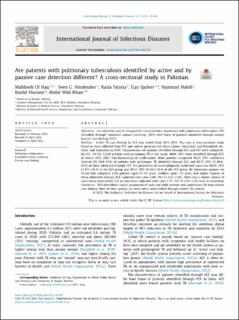Are patients with pulmonary tuberculosis identified by active and by passive case detection different? A cross-sectional study in Pakistan
Ul Haq, Mahboob; Hinderaker, Sven Gudmund; Fatima, Razia; Qadeer, Ejaz; Habib, Hammad; Hussain, Kashif; Khan, Abdul Wali
Journal article, Peer reviewed
Published version

Åpne
Permanent lenke
https://hdl.handle.net/11250/3039829Utgivelsesdato
2022Metadata
Vis full innførselSamlinger
Originalversjon
International Journal of Infectious Diseases. 2022, 121, 39-46. 10.1016/j.ijid.2022.04.055Sammendrag
Objectives
Our objective was to compare the characteristics of patients with pulmonary tuberculosis (TB) identified through “extended contact screening” (ECS) with those of patients identified through routine passive case finding (PCF).
Methods
Active TB case finding by ECS was tested from 2013–2015. This was a cross-sectional study based on data collected from ECS and routine program data from Lahore, Faisalabad, and Rawalpindi districts, and Islamabad in 2015. Characteristics of patients identified through ECS and PCF were compared.
Results
Of the 12,114 patients with pulmonary TB in the study, 4604 (38%) were identified through ECS, of whom 4052 (88%) had bacteriological confirmation. Male patients comprised 56.2% (95% confidence interval [CI] 54.8–57.6) of patients with pulmonary TB identified through ECS and 49.7% (95% CI 48.6–50.8) of those identified through PCF. The proportion of bacteriologically confirmed cases was 88.0% (95% CI 87.1–88.9) in the ECS group and 50.3% (95% CI 49.2–51.4) in the PCF group. By regression analysis we found that compared with patients aged 15–44 years, children aged <15 years had higher chances of being identified through ECS (adjusted odds ratio 2.69; 95% CI 2.21–3.28). There was a higher chance of cases being detected by ECS in Faisalabad (adjusted odds ratio 2.57; 95% CI 2.01–3.29) than in Islamabad.
Conclusion
ECS identified a higher proportion of male and child patients with pulmonary TB than routine case finding; both of these groups are more often unidentified through routine TB control.
